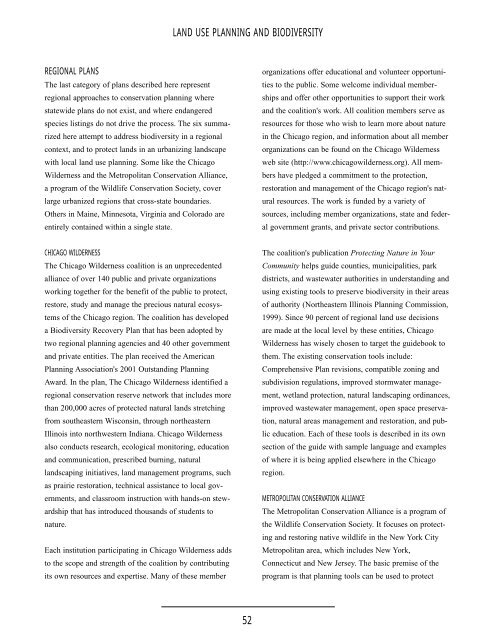Integrating Land Use Planning and Biodiversity - Defenders of Wildlife
Integrating Land Use Planning and Biodiversity - Defenders of Wildlife
Integrating Land Use Planning and Biodiversity - Defenders of Wildlife
You also want an ePaper? Increase the reach of your titles
YUMPU automatically turns print PDFs into web optimized ePapers that Google loves.
LAND USE PLANNING AND BIODIVERSITY<br />
REGIONAL PLANS<br />
The last category <strong>of</strong> plans described here represent<br />
regional approaches to conservation planning where<br />
statewide plans do not exist, <strong>and</strong> where endangered<br />
species listings do not drive the process. The six summarized<br />
here attempt to address biodiversity in a regional<br />
context, <strong>and</strong> to protect l<strong>and</strong>s in an urbanizing l<strong>and</strong>scape<br />
with local l<strong>and</strong> use planning. Some like the Chicago<br />
Wilderness <strong>and</strong> the Metropolitan Conservation Alliance,<br />
a program <strong>of</strong> the <strong>Wildlife</strong> Conservation Society, cover<br />
large urbanized regions that cross-state boundaries.<br />
Others in Maine, Minnesota, Virginia <strong>and</strong> Colorado are<br />
entirely contained within a single state.<br />
organizations <strong>of</strong>fer educational <strong>and</strong> volunteer opportunities<br />
to the public. Some welcome individual memberships<br />
<strong>and</strong> <strong>of</strong>fer other opportunities to support their work<br />
<strong>and</strong> the coalition's work. All coalition members serve as<br />
resources for those who wish to learn more about nature<br />
in the Chicago region, <strong>and</strong> information about all member<br />
organizations can be found on the Chicago Wilderness<br />
web site (http://www.chicagowilderness.org). All members<br />
have pledged a commitment to the protection,<br />
restoration <strong>and</strong> management <strong>of</strong> the Chicago region's natural<br />
resources. The work is funded by a variety <strong>of</strong><br />
sources, including member organizations, state <strong>and</strong> federal<br />
government grants, <strong>and</strong> private sector contributions.<br />
CHICAGO WILDERNESS<br />
The Chicago Wilderness coalition is an unprecedented<br />
alliance <strong>of</strong> over 140 public <strong>and</strong> private organizations<br />
working together for the benefit <strong>of</strong> the public to protect,<br />
restore, study <strong>and</strong> manage the precious natural ecosystems<br />
<strong>of</strong> the Chicago region. The coalition has developed<br />
a <strong>Biodiversity</strong> Recovery Plan that has been adopted by<br />
two regional planning agencies <strong>and</strong> 40 other government<br />
<strong>and</strong> private entities. The plan received the American<br />
<strong>Planning</strong> Association's 2001 Outst<strong>and</strong>ing <strong>Planning</strong><br />
Award. In the plan, The Chicago Wilderness identified a<br />
regional conservation reserve network that includes more<br />
than 200,000 acres <strong>of</strong> protected natural l<strong>and</strong>s stretching<br />
from southeastern Wisconsin, through northeastern<br />
Illinois into northwestern Indiana. Chicago Wilderness<br />
also conducts research, ecological monitoring, education<br />
<strong>and</strong> communication, prescribed burning, natural<br />
l<strong>and</strong>scaping initiatives, l<strong>and</strong> management programs, such<br />
as prairie restoration, technical assistance to local governments,<br />
<strong>and</strong> classroom instruction with h<strong>and</strong>s-on stewardship<br />
that has introduced thous<strong>and</strong>s <strong>of</strong> students to<br />
nature.<br />
Each institution participating in Chicago Wilderness adds<br />
to the scope <strong>and</strong> strength <strong>of</strong> the coalition by contributing<br />
its own resources <strong>and</strong> expertise. Many <strong>of</strong> these member<br />
The coalition's publication Protecting Nature in Your<br />
Community helps guide counties, municipalities, park<br />
districts, <strong>and</strong> wastewater authorities in underst<strong>and</strong>ing <strong>and</strong><br />
using existing tools to preserve biodiversity in their areas<br />
<strong>of</strong> authority (Northeastern Illinois <strong>Planning</strong> Commission,<br />
1999). Since 90 percent <strong>of</strong> regional l<strong>and</strong> use decisions<br />
are made at the local level by these entities, Chicago<br />
Wilderness has wisely chosen to target the guidebook to<br />
them. The existing conservation tools include:<br />
Comprehensive Plan revisions, compatible zoning <strong>and</strong><br />
subdivision regulations, improved stormwater management,<br />
wetl<strong>and</strong> protection, natural l<strong>and</strong>scaping ordinances,<br />
improved wastewater management, open space preservation,<br />
natural areas management <strong>and</strong> restoration, <strong>and</strong> public<br />
education. Each <strong>of</strong> these tools is described in its own<br />
section <strong>of</strong> the guide with sample language <strong>and</strong> examples<br />
<strong>of</strong> where it is being applied elsewhere in the Chicago<br />
region.<br />
METROPOLITAN CONSERVATION ALLIANCE<br />
The Metropolitan Conservation Alliance is a program <strong>of</strong><br />
the <strong>Wildlife</strong> Conservation Society. It focuses on protecting<br />
<strong>and</strong> restoring native wildlife in the New York City<br />
Metropolitan area, which includes New York,<br />
Connecticut <strong>and</strong> New Jersey. The basic premise <strong>of</strong> the<br />
program is that planning tools can be used to protect<br />
52
















![[PDF] Community Development Toolkit - CommDev](https://img.yumpu.com/48616495/1/184x260/pdf-community-development-toolkit-commdev.jpg?quality=85)
